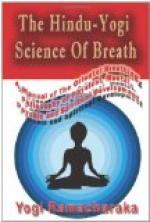The following exercise in Rhythmic Breathing should be thoroughly mastered, as it forms the basis of numerous other exercises, to which reference will be made later.
(1) Sit erect, in an easy posture, being sure to hold the chest, neck and head as nearly in a straight line as possible, with shoulders slightly thrown back and hands resting easily on the lap. In this position the weight of the body is largely supported by the ribs and the position may be easily maintained. The Yogi has found that one cannot get the best effect of rhythmic breathing with the chest drawn in and the abdomen protruding.
(2) Inhale slowly a
Complete Breath, counting six pulse
units.
(3) Retain, counting three pulse units.
(4) Exhale slowly through
the nostrils, counting six pulse
units.
(5) Count three pulse beats between breaths.
(6) Repeat a number
of times, but avoid fatiguing yourself
at the start.
(7) When you are ready
to close the exercise, practice the
cleansing breath, which
will rest you and cleanse the lungs.
After a little practice you will be able to increase the duration of the inhalations and exhalations, until about fifteen pulse units are consumed. In this increase, remember that the units for retention and between breaths is one-half the units for inhalation and exhalation.
Do not overdo yourself in your effort to increase the duration of the breath, but pay as much attention as possible to acquiring the “rhythm,” as that is more important than the length of the breath. Practice and try until you get the measured “swing” of the movement, and until you can almost “feel” the rhythm of the vibratory motion throughout your whole body. It will require a little practice and perseverance, but your pleasure at your improvement will make the task an easy one. The Yogi is a most patient and persevering man, and his great attainments are due largely to the possession of these qualities.
CHAPTER XIV.
PHENOMENA OF YOGI PSYCHIC BREATHING.
With the exception of the instructions in the Yogi Rhythmic Breathing, the majority of the exercises heretofore given in this book relate to the physical plane of effort, which, while highly important in itself, is also regarded by the Yogis as in the nature of affording a substantial basis for efforts on the psychic and spiritual plane. Do not, however, discard or think lightly of the physical phase of the subject, for remember that it needs a sound body to support a sound mind, and also that the body is the temple of the Ego, the lamp in which burns the light of the Spirit. Everything is good in its place, and everything has its place. The developed man is the “all-around man,” who recognizes body, mind and spirit and renders to each its due. Neglect of either is a mistake which must be rectified sooner or later; a debt which must be repaid with interest.




